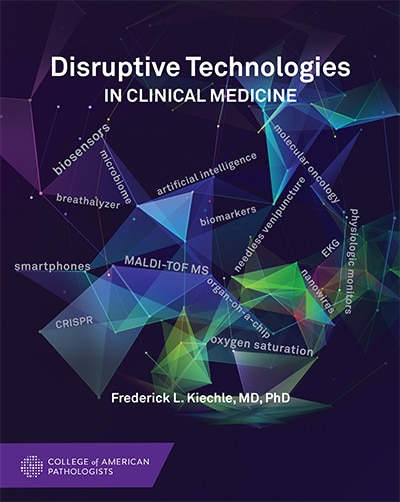December 2023—The recent CAP proficiency testing questionnaire was meant to be the coup de grâce. Hematology PT participants were asked about their band neutrophil reporting practices and, given that these manually generated counts were supposedly on their way out decades ago, the authors of the survey questionnaire expected to see very little activity. The survey, they hoped, would be a way to pound the final, data-driven nail in the coffin. Or, as lead author Maria (Ria) Vergara-Lluri, MD, puts it, “We thought this had all been laid to rest 30 years ago.” It wasn’t. Says Dr. Vergara-Lluri: “Surprise: 86 percent of labs that participated still report bands.” The results of the survey upended many of the assumptions, if not hopes, the authors might have had. Among laboratories that reported manual differentials, they found that most reported bands (4,554 of 5,268). Moreover, only 73 percent reported band reference ranges. On the morphologic challenge, bands classified as “easy” were indeed easy—participants classified them well.
Read More »2023 Issues
In fee schedule final rule, lower cuts than proposed
December 2023—In the 2024 Medicare physician fee schedule final rule, the Centers for Medicare and Medicaid Services reacted favorably to the CAP’s advocacy to mitigate payment decreases to pathologists next year. Overall, payments to pathologists are expected to decrease by an estimated 2.7 percent.
Read More »New guidance on lab analysis in diabetes
December 2023—The third and latest edition of recommendations for laboratory analysis in diagnosing and managing diabetes mellitus, released this summer, provide guidance on, among other things, ketone testing, glycolysis, and point-of-care testing. The last such recommendations were published in 2011.
Read More »In ED/urgent cares, the lab tests and the POC team
December 2023—A point-of-care testing team from TriCore was part of standing up three dual emergency department/urgent care centers in as many years, with a fourth set to open in March 2024. “They are super busy, as was expected. There’s a great need for this type of site,” says Kathleen David, MT(ASCP).
Study of suspected transfusion reactions to begin Jan. 1
A new CAP Quality Practices study on rates and turnaround times for investigating and reporting suspected transfusion reactions will begin on Jan. 1, 2024. Enrollment is open now and will continue through Feb. 5, 2024.
Read More »Digital pathology and AI—drivers, budgets, and jobs
December 2023—Digital pathology and AI—the push, the potential, the changing questions, the reimbursement, and the caution. All that and more came up when CAP TODAY publisher Bob McGonnagle on Oct. 17 led a conversation online with pathologists and industry representatives.
Read More »Savings follow allergy, autoimmune test consolidation
December 2023—Hoi-Ying Elsie Yu, PhD, D(ABCC), isn’t new to workflow optimization. As system director of chemistry, point-of-care testing, and preanalytics for Geisinger Medical Center in Danville, Pa., for the past decade, she has undertaken initiatives to maximize efficiency in complicated parts of the laboratory whenever she can.
Read More »Phlebotomy program gives lift to lab, community
December 2023—The clinical laboratory at Children’s Hospital of Philadelphia is solving two problems at once: its phlebotomist staffing shortage and the need for some in its community to learn a new skill and obtain employment.
Read More »LDT proposal on the radar—little detail, clarity needed
December 2023—For most, laboratory staffing woes continue, despite some letup post-pandemic. CAP TODAY publisher Bob McGonnagle on Nov. 7 got a sampling of where staffing stands as the year end approaches, in his conversation online with members of the Compass Group, an organization of not-for-profit IDN system lab leaders who collaborate to identify and share best practices and strategies. But first a few words from them about the Food and Drug Administration’s proposed rule on laboratory-developed tests.
Read More »AMP case report: Potential von Hippel-Lindau syndrome in a patient with negative germline testing
CAP TODAY and the Association for Molecular Pathology have teamed up to bring molecular case reports to CAP TODAY readers. AMP members write the reports using clinical cases from their own practices that show molecular testing’s important role in diagnosis, prognosis, and treatment. The following report comes from Washington University School of Medicine in St. Louis. If you would like to submit a case report, please send an email to the AMP at amp@amp.org. For more information about the AMP and all previously published case reports, visit www.amp.org.
Read More »From the President’s Desk
December 2023—About five years ago, when I was serving in my first term on the CAP Board of Governors, I attended a House of Delegates meeting where we had a candidate forum with several people on stage competing for just a few Board slots. Of the half-dozen or so people, only one or two were women and none was a minority. That’s when one delegate stood up and, with a single question, altered the course of our entire organization: “When will the CAP have candidates for higher office who look like the CAP membership?”
Read More »Anatomic pathology selected abstracts
December 2023—Cytomegalovirus hepatitis in allograft livers is a significant infectious complication for which the histology historically has been described as overlapping that of acute cellular rejection, a diagnosis that compels a different treatment regimen. The authors conducted a study to update the clinicopathologic features of cytomegalovirus (CMV) hepatitis and explore its clinical and histologic relationship with acute cellular rejection (ACR). They performed a retrospective analysis of 26 patients, across four institutions, who were diagnosed with CMV hepatitis, assessing clinical, histologic, and IHC features. Patients were predominantly CMV donor positive/recipient negative (D+/R-; n=9 of 15) and received a diagnosis of CMV hepatitis at a mean age of 52 years (standard deviation [SD], 17 years) and at a mean interval of 184 days (SD, 165 days) from transplantation. Mean CMV viral load at diagnosis was 241,000 IU/mL (SD, 516 000 IU/mL), and liver biochemical enzymes were elevated (mean alanine aminotransferase, 212 U/L [SD, 180 U/L]; mean aspartate aminotransferase, 188 U/L [SD, 151 U/L]; and mean alkaline phosphatase, 222 U/L [SD, 153 U/L]).
Read More »Clinical pathology selected abstracts
December 2023—Efforts to develop biomarkers that help predict risk factors for preeclampsia/eclampsia and to better understand the trends and implications related to new-onset hypertensive disorders in pregnancy have grown. New-onset hypertension arising during pregnancy (gestational hypertension and preeclampsia/eclampsia) is associated with coronary heart disease, heart failure, stroke, and other cardiovascular-related mortality. Hypertensive disorders of pregnancy have grown into major public health problems that contribute to maternal morbidity, mortality, and future risk of cardiovascular disease. The authors conducted a study to describe contemporary trends in new-onset hypertensive disorders of pregnancy in the United States. They conducted a serial cross-sectional analysis of 51,685,525 live births to women aged 15 to 44 years, from 2007 to 2019, using the Centers for Disease Control and Prevention’s natality database.
Read More »Molecular pathology selected abstracts
December 2023—Immune checkpoint blockade therapy has dramatically altered treatment options for a variety of cancers. A high tumor mutation burden (TMB) is considered one of the strongest predictors of immune checkpoint blockade response. DNA mismatch repair deficiency (MMRd) is associated with a high TMB, and many tumors associated with MMRd have shown excellent response to immunotherapy. However, most MMRd tumors do not show durable response to treatment with immune checkpoint blockade (ICB). Intratumor heterogeneity may further mediate response to ICB therapy.
Read More »Q&A column
December 2023 Q. When using a sodium citrate blue-top tube due to platelet clumping, should the sample be kept warm, and does it have to be run within a certain time frame? Read answer. Q. Does the CAP require instrument-to-instrument comparability studies at least twice a year for waived point-of-care testing instruments, such as glucose meters, or nonwaived instruments, such as critical care analyzers? Are we required to perform a linearity study twice a year on all waived and nonwaived POC testing instruments? Read answer.
Read More »Newsbytes
December 2023—While many dismiss the saying “Nothing lasts forever” with a simple shrug, those three words may cause angst in those anticipating the demise of their laboratory information system.
Read More »Put It on the Board
December 2023—The Food and Drug Administration granted approval for EntroGen’s CRCdx RAS Mutation Detection Kit as a companion diagnostic for Vectibix (panitumumab), used in the treatment of colorectal cancer.
Read More »In memoriam
John Kelly Duckworth, MD 1928–2023 December 2023—John Kelly Duckworth, MD, a member of the CAP Board of Governors from 1987 to 1993, died on Sept. 14 at age 95. Dr. Duckworth was the second chair of the CAP Commission on Laboratory Accreditation. He also was chair of the Council on Practice Management, vice chair of the Council on Scientific Affairs, ...
Read More »Test adds twists to lung disease diagnosis
November 2023—It was a mystery, wrapped less in an enigma than a few layers of bafflement, surprise, and mild irritation. Call it the Case of the Split Lung Specimens. The first hint something was amiss came when Alain Borczuk, MD, vice chair of anatomic pathology and co-director of thoracic pathology, Northwell Health, noticed that he and his colleagues were receiving more insufficient bronchoscopy specimens than usual. “When I say ‘increasing’—we don’t get that many bronchoscopies. It’s not like colon polyps,” says Dr. Borczuk, who is also director of oncologic pathology, Northwell Health Cancer Institute. Normally they would get a handful a week, some of them straightforward cancer cases, although these additional cases were tied to noncancerous conditions. And then the plot thickened even further, with missing pieces—literally. Though no guideline clearly states what constitutes an adequate specimen, Dr. Borczuk says, the samples he and his colleagues were seeing fell markedly short.
Read More »New guidance in checklist on AMR and mass spec
November 2023—In the 2023 edition of the CAP accreditation program checklists is new guidance on analytical measurement range verification and new and revised requirements for mass spectrometry.
Read More »Point-of-care testing scorecard spotlights hits and misses
November 2023—At the point of care, there are testing wins, some losses, and plenty of pitfalls. “Point-of-care coordinators all have the same problems,” says Meaghan Gladstone, applications consultant at Werfen.
In some settings, alternatives to HbA1c acceptable
November 2023—Glycated albumin and fructosamine are highly specific, with high levels suggesting hyperglycemia. This points to their utility in monitoring glycemic control in people with diabetes. “They’re quite useful in the setting of overt hyperglycemia,” said Elizabeth Selvin, PhD, MPH, at this year’s meeting of the Association for Diagnostics and Laboratory Medicine.
Read More »Generative AI, from education to corner cases
Generative artificial intelligence—what it is, how it can be used in pathology, what stands in its way, why the excitement. CAP TODAY publisher Bob McGonnagle spoke about that and more with pathologists Bobbi Pritt, MD, MSc, and Scott Anderson, MD; Ajit Singh, PhD, of Stanford and Artiman Ventures; and Devon Snedden, a health care consultant in artificial intelligence. “There are a lot of excellent possibilities that we’re just starting to understand and explore for the field of pathology,” said Dr. Pritt of Mayo Clinic.
Read More »AI-driven spatial biology: the next next-gen sequencing
November 2023—Spatial biology may be an emerging field, but Kenneth Bloom, MD, says he and other pathologists have been doing it “since we got the microscope.” And he argues it’s going to become “the new, most important lens we look through.” The reason is the emergence of new cancer treatments like immunotherapy and, most importantly, antibody drug conjugates like Enhertu, says Dr. Bloom, head of pathology for Nucleai, a company specializing in AI-powered spatial biology.
Read More »Minds shift on digital path, ‘massive change’ predicted
Is digital pathology on the move? Two who know it well say it is. Esther Abels, a precision medicine and biomedical regulatory health science expert who is CEO of SolarisRTC and former president of the Digital Pathology Association, and Michael Rivers, vice president/lifecycle leader of digital pathology at Roche Tissue Diagnostics, spoke in September with CAP TODAY publisher Bob McGonnagle, who got their take on where things stand.
Read More »Pathology navigators bring molecular test efficiencies
November 2023—Few things in the laboratory can do so much at once: boost histotechnologist productivity, safeguard tissue, offer a career path and help retain staff, keep watch on test utilization, and reduce the number of calls to pathologists and turnaround time, all while advocating for the patient.
Read More »Reports revisited—panel on preferences and pain points
November 2023—Reports—integrated or otherwise—were up for discussion when CAP TODAY publisher Bob McGonnagle convened online in October a group of informatics experts, who spoke of the need for simplicity in a time of growing complexity, ease of access, where Epic isn’t strong. The full conversation follows.
Read More »From the President’s Desk
November 2023—For 100 years, pathologists have been called “the doctor’s doctor.” We have traditionally done our work in the background, interacting mostly with other physicians and not visible to or known by patients.
Read More »Clinical pathology selected abstracts
November 2023—Among the many reasons unnecessary laboratory tests are ordered in a hospital are preselected orders on order sets, clinician habits, and trainee concerns. Laboratory tests are among the highest volume procedures performed in inpatient hospital care. Excessive use of these tests can lead to patient discomfort as a result of unnecessary phlebotomy and contribute to iatrogenic anemia and increased risk of bloodstream infections. It can also contribute to the rising cost of medical care. Many laboratory stewardship programs have been developed to improve how clinicians order and use lab tests.
Read More »Anatomic pathology selected abstracts
November 2023—Claudin-4 is a sensitive and specific marker for carcinoma in effusion cytology. The authors examined the diagnostic use of claudin-4 versus MOC-31 and Ber-EP4 by comparing their sensitivity, specificity, positive predictive value, and negative predictive value in differentiating carcinoma from mesothelioma and benign/mesothelial hyperplasia in effusion specimens. They conducted a retrospective study on a cohort of 229 cytology specimens, including 211 effusion fluid and 18 fine-needle aspiration specimens. The cytologic categories included 134 carcinoma, 28 mesothelioma, 46 indefinite (suspicious and atypical), and 21 benign.
Read More »Molecular pathology selected abstracts
November 2023—Dilated cardiomyopathy is characterized by dilation and weakening of one or both ventricles combined with impaired contractility. Although several external etiologies are associated with dilated cardiomyopathy (DCM), a familial form (comprising about half the known cases of DCM) has symptoms that tend to arise in mid-adulthood. Despite the genetic nature of the familial form, little is known about the genetic profile of the disease. Black patients have an increased familial risk of DCM and often have a worse prognosis. The authors conducted a study in which they used genomic ancestry to compare the rare variant genetic architecture of DCM within a diverse patient population.
Read More »Q&A column
November 2023 Q. A molecular laboratory received an order from an oncologist for next-generation sequencing testing. The patient’s tissue sample was in the custody of a different laboratory, which has a policy requiring patient consent to release materials for reference lab testing. The oncologist planned to obtain consent from the patient during a scheduled appointment, but the patient’s condition unexpectedly worsened and the patient could no longer travel for the appointment. Neither the custodial laboratory nor the treating health system have mechanisms for electronic consent. As a result of the lack of options for obtaining consent remotely and the custodial laboratory’s stringent consent policy, potentially life-altering NGS testing was delayed for more than a month. Is this restrictive approach to releasing patient material for reference laboratory testing supported by CAP guidelines? Read answer. Q. Is it acceptable to perform weak D testing on a newborn who has an RhD-negative blood type and a positive direct antiglobulin test? We know a positive DAT might cause false-positive results on an Rh test, but can it cause false-negative results? Read answer.
Read More »Newsbytes
November 2023—“The best way to have a good idea is to have a lot of ideas,” according to Linus Pauling, a chemist and chemical engineer who, among other accomplishments, helped create a form of synthetic plasma. But when there is no structure in place to nurture those ideas, the result can be “a lot of people focused in a lot of different directions,” says Sky Soom, innovation analyst with Sonora Quest Laboratories.
Read More »Put It on the Board
November 2023—Roche announced last month the U.S. launch of its Cobas Connection Modules (CCM) Vertical, the elevator and overhead components of its fully automated and modular CCM system to help low-, mid-, and high-volume laboratories optimize space, productivity, and patient care.
Read More »Digital path’s star rises from the mists
October 2023—In living up to its promise as a new technology that will revolutionize clinical care through greater ease, speed, and accuracy of diagnosis, digital pathology has been sluggish. While many analysts, starting at least two decades ago, forecasted that digital pathology would elbow aside glass slides for good, that milestone is still far out of reach. As health economist and chief executive officer of the New York City-based digital pathology company Paige, Andy Moye, PhD, puts it bluntly: “In probably 90 to 95 percent of the cases in the U.S., a pathologist still makes the diagnosis of cancer the way they did it back in 1910: by looking at a glass slide under a microscope.” Mark Lloyd, PhD, vice president of pathology for Fujifilm, says he wouldn’t be surprised to hear that perhaps only five percent to 10 percent of hospitals have moved beyond using only glass slides to offer pathologists digital pathology capability. In fact, Dr. Lloyd thinks those percentages are overstated. What is the market share for the clinical use of digital pathology?
Read More »Looking ahead to respiratory virus season
October 2023—With respiratory virus season near, those with a close eye on it in August gave the lay of the land for test algorithms, technologies, and forecasts, even as SARS-CoV-2 and RSV cases were rising in parts of the country.
Read More »Soon to be required: current susceptibility testing breakpoints
October 2023—A CAP accreditation program requirement that microbiology laboratories use current antimicrobial susceptibility testing breakpoints, which was added to the checklist in 2021, will go into effect Jan. 1, 2024.
Read More »Inside lab’s experience with assays for Alzheimer’s
October 2023—Orders for cerebrospinal fluid testing for Alzheimer’s disease have grown at Mayo Clinic since spring 2020, when testing was first offered. When aducanumab was approved in May 2021, test orders jumped.
Read More »Fast or comprehensive? Lab offers both for NSCLC
October 2023—For molecular testing in oncology, the choice is often fast or slow. PCR-based platforms are rapid, and comprehensive genomic profiling by next-generation sequencing is slower, and each has its pros and cons.
Read More »New guide to whole blood viscoelastic assays: hemostasis, testing, cases, and applications
October 2023—New this month from CAP Publications is Whole Blood Viscoelastic Assays in Clinical Diagnosis: An Illustrated Case-Based Guide. Viscoelastic testing was designed to determine the cause of intraoperative or trauma-related bleeding to guide hemostatic therapy. CAP TODAY asked the book’s editor, Oksana Volod, MD, about the guide. See her answers and a sample chapter. Dr. Volod is professor of pathology and director of the coagulation consultative service, Cedars-Sinai Medical Center, Los Angeles.
Read More »AMP case report: Identification of multiple germline cancer predisposing gene variants in a single patient during tumor sequencing analysis
October 2023—Next-generation sequencing of tumor tissue has important implications in solid and hematologic malignancies because it can identify genomic variants that provide diagnostic, prognostic, and predictive information to guide clinical management. Variants identified on tumor sequencing can be classified as somatic (acquired after conception) or inherited through germline.
Read More »In hematology, making the most of automated solutions
October 2023—Hematology analyzers and the related workflow, expertise, efficiency, and IT matters were the topic of a roundtable when CAP TODAY publisher Bob McGonnagle met online Aug. 29 with two pathologists and representatives from Horiba, Siemens, Sysmex, CellaVision, Sight, and Abbott. Their conversation follows.
Fernando Chaves, what are the advances in artificial intelligence in the field of hematology, particularly automated hematology, since we spoke during our roundtable at this time last year?
Fernando Chaves, MD, global head of hematology, Siemens Healthineers: Technology now enables full-field digital morphology, a full image of the entire slide scan. Now we can do with hematology what has been done for over a decade in surgical pathology.
From the President’s Desk
October 2023—In my long career, I’ve met a lot of pathologists. The military pathologist. The private practice pathologist who drives 75 miles each way to serve patients at a small rural hospital. The academic pathologist frantically writing a research grant proposal after a full day of clinical service. The lab director struggling to keep up with a rapidly growing specimen volume.
Read More »Clinical pathology selected abstracts
October 2023—Several large randomized controlled trials have shown the safety of tolerating hemoglobin levels as low as 7 g/dL in critically ill hemodynamically stable children. These trials have led to recent guidelines advocating for restrictive transfusion therapy, which is significantly changing practices in pediatric critical care.
Read More »Anatomic pathology selected abstracts
October 2023—Special AT-rich sequence-binding protein 2, or SATB2, induces local chromatin loops to facilitate transcription. SATB2 immunostaining is commonly used as a marker for colorectal adenocarcinoma and osteosarcoma. The authors conducted a study to better understand the prevalence and diagnostic value of SATB2 expression in cancer by analyzing a comprehensive set of human tumors. SATB2 expression was analyzed in 15,012 tissue samples from 120 tumor types and subtypes and 608 samples from 76 nonneoplastic tissue types using IHC in a tissue microarray format. SATB2 positivity was found in 89 of the 120 (74 percent) tumor types—59 of the 120 (49 percent) had at least one moderately positive tumor and 38 of the 120 (32 percent) had at least one strongly positive tumor.
Read More »Molecular pathology selected abstracts
October 2023—Ovarian cancer is the eighth most common cancer in women. There are several histological types of ovarian neoplasms, and all rank among the deadliest gynecological cancers. However, those with homologous recombination deficiency (HRD) may benefit from a recently discovered category of drugs, called poly ADP-ribose polymerase inhibitors (PARPi). The homologous recombination repair pathway, which is responsible for repairing double-strand DNA damage, involves several genes, including BRCA1, BRCA2, and ATM. People with germline or somatic deleterious alterations of these genes are at higher risk of certain malignancies, such as ovarian, breast, prostate, and pancreatic cancers.
Read More »Q&A column
October 2023 Q. What is the total allowable error for lupus anticoagulant testing? Read answer. Q. Our laboratory may relocate to a building five blocks from our current hospital. What kind of instrument validation or verification studies do we need to perform following a move? When should we update the address on our CLIA license and for CAP accreditation? Are we required to have a new CAP inspection before or after testing patient samples at the new location? Read answer.
Read More »Newsbytes
Ocotber 2023—Health care technology companies, by and large, are eager to share product metrics—that is, standalone product performance—with potential pathology lab clients but less eager to share how those technologies may impact laboratory workflow and decision-making.
Read More »Put It on the Board
October 2023—The Food and Drug Administration has granted clearance to Streck’s MDx-Chex for BC-GP and MDx-Chex for BC-GN for use in diagnostic procedures. They are quality controls designed to verify the performance of the Luminex Verigene Blood Culture Gram-Positive (BC-GP) and Gram-Negative (BC-GN) tests for bloodstream infection and sepsis.
Read More »In memoriam
October 2023—Thomas Dermott Trainer, MD, a member of the CAP Board of Governors from 1994 to 2000 and secretary-treasurer from 1999 to 2000, died on June 10 at age 94.
Read More »Tests for paraneoplastic syndromes in neurology
September 2023—Laboratory testing for paraneoplastic neurologic syndromes is neither commonplace nor cheap. It also comes with its own enigmatical math, as Michael Levy, MD, PhD, recently experienced. As the director of the Neuroimmunology Clinic and Research Laboratory in Massachusetts General Hospital’s Department of Neurology, Dr. Levy keeps an eye on PNS laboratory testing (which is performed at Mayo Clinic) at his institution.
Many knots to untangle in lab test names
September 2023—Ambiguities, inconsistencies, omissions, and other defects in the naming of laboratory tests can send test orders and results interpretation awry, particularly with some of the most common tests. Even among clinicians and laboratorians working at the same hospital for years, smooth sailing is not guaranteed. The authors of a study published in Archives of Pathology & Laboratory Medicine hope to change that. Their aim is to alert patient-facing providers and laboratories to the risks that ambiguous or nonstandardized laboratory test naming poses and to provide practical rules for minimizing those risks.
For infectious disease, what tests and at what time in disease course
September 2023—For the tickborne and mosquito-borne arboviruses, which are frequently more transient in blood and tissue than other pathogens, both molecular and serologic testing have a place in the diagnostic toolkit.
Read More »Lab’s steps to fewer contaminated urine cultures
September 2023—A casual comment made in a routine exchange in an Avera McKennan Hospital laboratory sparked a five-year campaign to bring down the urine culture contamination rate. “I feel like all I do is report contaminated cultures,” a microbiology technologist said in 2016.
Read More »New viscoelastic testing requirement in checklist
September 2023—A proficiency testing accreditation requirement in the new checklist edition was revised to add clarification, and a new requirement on viscoelastic testing will close an existing gap.
Read More »People, partners, and platforms at the point of care
September 2023—Point-of-care testing—the requests and the committees that oversee them, the connectivity, what AI might bring. CAP TODAY publisher Bob McGonnagle on July 21 met online with a laboratory operations director and a medical director from large health systems and with company representatives for a look at where things stand today. Their conversation follows.
Disruptive technologies—what impact on lab workflow?
September 2023—New from CAP Publications is Disruptive Technologies in Clinical Medicine, by Frederick Kiechle, MD, PhD. In his new book Dr. Kiechle says “disruptive technologies offer new paradigms in diagnostic medicine.” Technology-driven disruptions are stimulated by the need to improve patient care, he writes, and they have been “a feature of the practice of clinical pathology since the inception of the first clinical laboratory in 1895 at the University of Pennsylvania, the William Pepper Laboratory.”
Read More »AMP case report: Lung micropapillary adenocarcinomas revisited
September 2023—CAP TODAY and the Association for Molecular Pathology have teamed up to bring molecular case reports to CAP TODAY readers. AMP members write the reports using clinical cases from their own practices that show molecular testing’s important role in diagnosis, prognosis, and treatment. The following report comes from Henry Ford Hospital. If you would like to submit a case report, please send an email to the AMP at amp@amp.org. For more information about the AMP and all previously published case reports, visit www.amp.org.
Read More »Genetic counseling within the laboratory: For oncology cases, lab’s consult service plugs gap
September 2023—What happens when an oncologist cannot confidently determine what type of genetic test to order for their patient? Where can a provider turn if they do not know whether a genetic variant is clinically actionable? As genetic testing becomes a more integral part of personalized medicine and health care in general, there is a growing need to bridge the gap between those skilled in molecular diagnostics and those on the patient-facing side of care. In response to this need, the Center for Integrated Diagnostics (CID), a high-complexity molecular diagnostics laboratory at Massachusetts General Hospital, created its Consultation Service.
Read More »From the President’s Desk
September 2023—In the past two years, I’ve written a lot in this column about leadership and why pathologists make natural health care leaders. Effective leaders emerge from a process of continual self-correction in those who constantly seek out new ideas and hone their leadership skills.
Read More »Clinical pathology selected abstracts
September 2023—Approximately 30 percent of U.S. employees report that they have been bullied in the workplace, and these numbers are even higher for remote workers. Bullying is defined as any act or situation in which someone is subjected to recurrent, systematic, serious negative or hostile behavior and long-lasting acts designed to oppress or abuse another person. This behavior may include belittling, humiliating, personally attacking, verbally criticizing, or intentionally excluding a coworker. Bullying can harm both the target of the attack and the organization that employs the bully and the targeted person. The potential negative effects on an organization can be high staff turnover, a decrease in employee performance and productivity, and an increase in errors and medical mistakes.
Read More »Anatomic pathology selected abstracts
September 2023—Understanding of the pathologic and molecular features of endometrial cancer has advanced measurably since the FIGO (International Federation of Gynecology and Obstetrics) staging system was updated in 2009. New treatments, results of clinical trials, and prognostic survival data that correlate with pathologic and surgical findings have been reported. Therefore, the FIGO Committee on Women’s Cancer determined that changes to the FIGO system were necessary. The goals of the revised staging system are to further clarify the diverse biologic nature of endometrial carcinomas with differing prognostic outcomes, better define the prognostic groups, and create substages that yield more appropriate surgical, radiation, and systemic therapies. The cancer committee developed a subcommittee on endometrial cancer staging in October 2021, of which the authors are members.
Read More »Molecular pathology selected abstracts
September 2023—Neurodegenerative diseases are a broad group of disorders characterized by progressive loss of nerve cells in the central or peripheral nervous system. These diseases are often chronic and incurable, with symptoms ranging from cognitive decline to motor or sensory dysfunction. There are many types of neurodegenerative diseases, with various underlying etiologies. One group of diseases, the synucleinopathies, are associated with the misfolding and aggregation of the protein α-synuclein. This group includes disease entities such as Parkinson disease, dementia with Lewy bodies, and multiple-system atrophy.
Read More »Q&A column
September 2023 Q. Some recent clinical guidelines recommend lower therapeutic and toxic limits for digoxin than those provided in assay package inserts. What therapeutic ranges and toxic thresholds should laboratories use? Read answer. Q. One of our providers noticed that two laboratories—one in New York and one in Florida—reported very different thyroid-stimulating hormone values for a patient and called our laboratory to determine which was correct. How should we handle such situations? Read answer.
Read More »Newsbytes
September 2023—The musician Frank Zappa said, “One size does not fit all,” a declaration that counters the claims of many clothing manufacturers and holds true for a variety of products, including, one could argue, digital scanners.
Read More »Put It on the Board
September 2023—A wrist-worn high-sensitivity cardiac troponin I monitor was one of the wearable devices and health monitors highlighted in a session on emerging technologies for point-of-care testing at the Association for Diagnostics and Laboratory Medicine meeting in July.
Read More »Letters
September 2023—I read with interest “In anatomic pathology labs, a balancing act” (August 2023). Some of the roundtable participants highlighted an area of next-generation-sequencing–based diagnostics that is a blind spot for pathologists, molecular biology tool manufacturers, and laboratory information system vendors—namely how to reduce the fractional cost of performing NGS-based analysis. On the topic of gene panels, the participants offered that the workflows are complex, reimbursement is relatively low, and startup costs are high—all true statements. However, I was struck that they evaluated the cost structure only in the setting of tissue oncology, with the implication being that the fully loaded cost of the diagnostic must be borne by the degree and level of oncology-based sequencing.
Read More »Low level limbo in HER2 breast cancer
August 2023—Seemingly channeling the inspiration of Magritte and his famous pipe, pathologists are painting a new picture of what has long been an everyday object in their own world: HER2. To paraphrase the master: Ceci n’est pas facile. For years, HER2 testing in breast cancer has seemed self-evident, ever since the HER2-targeted therapy trastuzumab and its companion diagnostic arrived on the scene a quarter of a century ago. Pathologists became comfortable using immunohistochemistry to identify 3+ cases and turning to in situ hybridization techniques to sort through less obvious ones. But early last summer, a variant of the drug, trastuzumab-deruxtecan (T-DXd), shook up that routine. When researchers presented results from the Destiny-Breast04 study at the 2022 ASCO annual meeting, showing that T-DXd significantly improves survival in so-called HER2-low metastatic breast cancer, attendees responded with a minutes-long standing ovation. They then returned from the meeting like evangelicals from the revival tent.
Read More »For patients, demystifying pathology reports
August 2023—With patient access to pathology reports now common via online portals, the question some have asked is what can be done to make them easier for patients to understand.
Read More »Few but notable— new accreditation checklist changes
August 2023—Climate control, calculation verification, block retention, and histocompatibility section director (technical supervisor) qualifications are among the areas in which laboratories can expect to see revisions in the new edition of the CAP laboratory accreditation checklists, to be released this month.
Read More »Upon viral infection, assessing the host nasal epigenome
August 2023—Analyzing the nasal epigenome can shed light on viral infections, strain differences, and potentially infection severity, and for influenza B in particular the results are striking.
Read More »In anatomic pathology labs, a balancing act
August 2023—Anatomic pathology laboratories—the pressures, the promise of technology to alleviate them, and the seemingly unprecedented rates of change. CAP TODAY publisher Bob McGonnagle gathered pathologists and company representatives online on June 21 to talk about it all. From pathologist coverage to IT, from tumor boards to questions job candidates in pathology should ask, here’s what they told us.
Read More »New cassette printer a standout? Users think so
August 2023—No jams, downtime, or lost time. Plenty of savings, speed, and employee satisfaction. Users of what General Data calls its next-generation cassette printer for histology laboratories say they’ve seen all that and more.
Read More »AMP case report: Small intragenic structural variants in SATB2-associated syndrome
CAP TODAY and the Association for Molecular Pathology have teamed up to bring molecular case reports to CAP TODAY readers. AMP members write the reports using clinical cases from their own practices that show molecular testing’s important role in diagnosis, prognosis, and treatment. The following report comes from Washington University School of Medicine in St. Louis.
Read More »Cytopathology in focus: How to approach cytology of unknown primary
August 2023—We discuss in this article a common problem that all cytopathologists come across frequently in their practice: tumors of unknown primary origin involving body fluids and other sites. Metastatic tumor cells can disseminate and colonize discontinuous secondary body sites.1 Such tumor metastases may be the patient’s initial presenting complaint to a family physician for deep-seated tumor primaries such as ovaries, pancreas, liver, and certain non-obstructive gastrointestinal tumors.
Read More »Cytopathology in focus: Impact of primary HPV testing on cytology lab statistical analysis
August 2023—Cytology gynecologic statistical laboratory data must be analyzed in the context of changing screening modalities and patient populations. This is especially important with the increasing use of primary high-risk HPV screening because diagnostic metrics will be markedly different in that patient population.
Read More »Cytopathology in Focus: Lung cytopathology reporting: WHO system and cases
August 2023—Accurate and timely diagnosis is the cornerstone of effective patient care, particularly in the field of pulmonary pathology. To address the challenges health care professionals face in diagnosing and reporting respiratory conditions, the International Academy of Cytology, together with the International Agency for Research on Cancer, recently developed the World Health Organization Reporting System for Lung Cytopathology
Read More »In memoriam
August 2023—Peachy Ridgway Gilmer Jr., MD, a member of the CAP Board of Governors from 1985 to 1991, died on June 18 at age 90. Dr. Gilmer was vice chair of the CAP Council on Education and Membership Services and a member of several CAP groups: the Commission on Laboratory Accreditation, the Council on Quality Assurance, and the Election Oversight, Planning and Priorities, and Surveys committees.
Read More »From the President’s Desk
August 2023—The benefit of the doubt: a risk worth taking in health care? Many of us work in practices, hospitals, or departments that are short-staffed. In the aftermath of the pandemic, it is harder now than ever to find qualified people, from pathologists to clinical laboratory scientists to phlebotomists. Those of us who still work in laboratories are feeling the stress of carrying an extraordinary load.
Read More »Clinical pathology selected abstracts
August 2023—Burnout has been reported to affect as many as 44 percent of physicians. It is listed in the International Classification of Diseases 11th Revision (ICD-11) and has been attributed to chronic workplace stress, emotional exhaustion, depersonalization, and a low sense of personal accomplishment. A social psychologist created the Maslach Burnout Inventory (MBI) tool to measure degrees of burnout. The 2018 Canadian Medical Association Physician Health Survey of 3,000 members found an overall burnout rate of 30 percent, and 28 percent of pathologists who responded to that survey indicated they were burned out. Physician burnout can have a significant negative impact on patient care, including on the amount of medical errors. It has been estimated that physician burnout costs the Canadian health care system CAD $185 million due to early retirement and CAD $27.9 million due to reduced professional work effort.
Read More »Anatomic pathology selected abstracts
August 2023—Gastric foveolar-type adenoma is a rare benign neoplasm that occurs sporadically or presents in patients with familial adenomatous polyposis. The molecular features of foveolar-type adenoma (FA) and the relationship between sporadic and syndromic lesions remain unclear. The authors conducted a study in which they performed clinicopathological, immunohistochemical, and genetic analyses of 18 sporadic and 30 familial adenomatous polyposis (FAP)-associated FAs. The majority of sporadic and FAP-associated FAs were located in the upper or middle third of the stomach on a background of fundic gland mucosa. Most lesions were low grade, but three had a high-grade component.
Read More »Molecular pathology selected abstracts
Augstus 2023—Atypical hemolytic uremic syndrome is a rare, potentially life-threatening thrombotic microangiopathy. The disorder causes tiny blood clots to form in blood vessels and results in organ damage. Clinical findings in atypical hemolytic uremic syndrome (aHUS) include hemolytic anemia, low platelet count, and acute kidney failure. In many cases, HUS is caused by Shiga toxin-producing E. coli, other infections, or certain medications, or it can result from other health conditions. The label “atypical” is used to delineate hemolytic uremic syndrome that is not due to any of these common causes.
Read More »Q&A column
August 2023 Q. Is there a CAP guideline that recommends that patients stop taking drugs that may interfere with a blood or urine test before providing a specimen? Read answer. Q. Can laboratory managers and supervisors assess the competency of testing personnel if they do not perform the lab tests themselves? Read answer.
Read More »Newsbytes
August 2023—How often do pathology departments underbill insurance companies for their services? And how much money do they lose because of underbilling mistakes? A prototype dashboard at Dartmouth Hitchcock Medical Center aims to answer those questions by using natural-language processing and machine-learning algorithms to flag pathology cases that are underbilled.
Read More »Put It on the Board
August 2023—The Association for Diagnostics and Laboratory Medicine (formerly AACC) and the American Diabetes Association last month issued guidelines and recommendations for laboratory analysis in the diagnosis and management of diabetes mellitus (Sacks DB, et al. Clin Chem. 2023;69[8]:808–868).
Read More »Turning questions to answers in drug testing
July 2023—As she surveys the opioid epidemic in North America, Christine Snozek, PhD, D(ABCC), could be tempted to think that a ripped-from-the-headlines reality has landed in clinical laboratories as well as on TV crime dramas. With the number of opioid-related deaths increasing in recent years, particularly since the start of the pandemic, drug testing demands have increased for labs as well, says Dr. Snozek, codirector of clinical chemistry and support services and director of point of care and central processing at Mayo Clinic in Arizona. If only she could turn to the entertainment industry for a technology-based solution. “I wish we had CSI lab capabilities,” she says, referring to the long-running police procedural. “You could run a sample and find all the drugs known to man on one test. If they could go ahead and release that technology, that would be wonderful,” jokes Dr. Snozek. Given that laboratories are unlikely to take a meeting with network executives, Dr. Snozek and others in the field will have to look elsewhere.
Read More »For SARS-CoV-2, clearing the air on EUA tests
July 2023—As the COVID-19 federal public health emergency drew to a close in mid-May, industry experts explained what will and won’t change for the laboratory and weighed the fallout from the drop-off in SARS-CoV-2 testing.
The human gut microbiome and blood biochemistry connection
July 2023—The human microbiome has been called the forgotten organ, and at one time it was. But not in the past 10 years. James Versalovic, MD, PhD, made that clear in his talk at the Association for Molecular Pathology meeting last year.
Read More »For sepsis Dx, MDW biomarker brought into the mix
July 2023—When Butler Health System in early 2020 installed the Beckman Coulter DxA 5000 automation line, its hospitals were among the first in the country to do so. At the same time, Butler went live with the DxH 900 hematology analyzer.
Read More »Cytomegalovirus in IBD: where to biopsy, whom to treat
July 2023—Though it’s been suggested that newer drugs have made cytomegalovirus less relevant in patients with inflammatory bowel disease, CMV remains an important opportunistic infection in patients with IBD. Knowing where to biopsy and how many are needed is one of the histologic challenges, said Joseph Misdraji, MD, associate professor of pathology, Yale School of Medicine, in a CAP22 session.
Read More »First a probe purchase, then an academic consortium
July 2023—Bringing new technology into laboratories is important for pathology as a field and for patients—and only getting more difficult. “Each new wave of technology is more complicated than the last,” Jeremy Segal, MD, PhD, said at the USCAP meeting this spring.
Read More »Lab leaders on moving markets and tipping points
July 2023—Digital pathology, the pathology workforce, and the clinical demand for subspecialty expertise were some of what Compass Group lab leaders took on in their June 6 conversation, with CAP TODAY publisher Bob McGonnagle leading the way.
AMP case report: A germline GATA2 c.121C>G (p.P41A) variant in a patient with an unusual acute promyelocytic leukemia
July 2023—A germline GATA2 c.121C>G (p.P41A) variant in a patient with an unusual acute promyelocytic leukemia CAP TODAY and the Association for Molecular Pathology have teamed up to bring molecular case reports to CAP TODAY readers. AMP members write the reports using clinical cases from their own practices that show molecular testing’s important role in diagnosis, prognosis, and treatment. The following report comes from Emory University School of Medicine. If you would like to submit a case report, please send an email to the AMP at amp@amp.org. For more information about the AMP and all previously published case reports, visit www.amp.org.
Read More »From the President’s Desk
July 2023—About a year ago, I used this column to talk about the CAP’s efforts to prioritize innovation and to create more pathways for staff and members to help keep us on the cutting edge. I know “innovation” can seem like a meaningless buzzword that organizations throw around without putting anything substantial behind it, so I wanted to come back to the topic and show that we really are taking it seriously at the CAP.
Read More »Clinical pathology selected abstracts
July 2023—Hemolytic disease of the fetus and newborn is caused by maternal immunoglobulin G crossing the placenta and binding to fetal RBC antigens. In severe cases, it results in fetal or neonatal anemia, edema, hepatosplenomegaly, and death. In China, antibodies to the ABO blood group system are the most common cause of hemolytic disease of the fetus and newborn (HDFN) and account for 85.3 percent of cases. This is followed by antibodies to the Rh blood group system, which account for 14.6 percent of HDFN cases. Other blood group systems, including Duffy, Kidd, and MNS, may also cause HDFN.
Read More »Anatomic pathology selected abstracts
July 2023—High-grade appendiceal mucinous neoplasm is a relatively recent term that describes a rare epithelial neoplasm of the appendix that demonstrates pushing-type invasion but high-grade cytologic atypia. Because it has been understudied, the authors conducted a multi-institutional retrospective study to describe the clinicopathologic features of high-grade appendiceal mucinous neoplasm (HAMN). They reviewed the clinical and histologic features of 35 HAMNs and the molecular features of eight of the cases. Patients were an average of 57 years old and most commonly presented with abdominal or pelvic pain. Histologically, 57 percent of the tumors showed widespread high-grade features.
Read More »Molecular pathology selected abstracts
July 2023—Non-muscle-invasive bladder cancer accounts for the majority of bladder tumors and is typically treated with transurethral resection of the bladder tumor followed by adjuvant intravesical Bacillus Calmette-Guérin instillations. However, the long-term effectiveness of Bacillus Calmette-Guérin (BCG) is limited, and patients with recurrent or progressive disease have lower survival rates. Understanding the genetic makeup of tumors and identifying molecular subtypes associated with BCG response could provide valuable insights that aid in developing personalized treatments. The authors conducted a study in which they performed whole-transcriptome sequencing of non-muscle-invasive bladder cancers (NMIBCs) from 132 patients who had never received BCG treatment and 44 patients whose cancer recurred after BCG treatment. Based on these patients’ results, the authors identified three unique molecular subtypes among the tumors—BRS1, 2, and 3. Patients with BRS3 showed increased epithelial-to-mesenchymal transition pathway activity and their tumors were enriched for mutations associated with the extracellular matrix when compared with the other two subtypes.
Read More »Q&A column
July 2023 Q. Should phosphate analysis be added to the comprehensive metabolic panel, especially given the test’s usefulness in distinguishing various bone disorders?Read answer. Q. Is it important to fast before a lipid panel? Read answer.
Read More »Newsbytes
July 2023—The Permanente Medical Group, Oakland, Calif., has launched the Kaiser Permanente Northern California Division of Research Augmented Intelligence in Medicine and Healthcare Initiative Coordinating Center, or AIM-HI. The program will support a national research effort focused on evaluating artificial intelligence and machine-learning algorithms to enhance diagnostic decision-making in health care.
Read More »Put It on the Board
July 2023—Roche’s Elecsys beta-Amyloid (1-42) CSF II (Abeta42) and Elecsys Total-Tau CSF assays (tTau) have received Food and Drug Administration 510(k) clearance. They are used as a tTau/Abeta42 ratio, which will become available in the fourth quarter of this year.
Read More »In search for Candida auris, labs all in
June 2023—A bad-news, good-news, bad-news, good-news bass line thrums through the ongoing story of Candida auris as it continues to spread in the United States. Initially identified in Japan, in 2009, in an ear specimen—hence the auris—the yeast was first reported in the United States in 2016. Like certain other pathogens, C. auris’ domestic presence appeared to be linked to travel-related cases, then quickly spread, first to the metropolitan regions of Chicago and New York City and now to more than half the states. That’s worrisome. Yet the spread hasn’t been unbridled. Early fears that it would sweep indiscriminately through all patient populations have not been realized. “It’s not as virulent as albicans,” says Sixto M. Leal Jr., MD, PhD, director of the clinical microbiology laboratory and of the fungal reference laboratory, University of Alabama at Birmingham, and a member of the CAP Microbiology Committee. “It’s about as virulent as Candida glabrata. It’s not too much of a significant threat if you’re healthy.”
Lyme algorithms: stick to standard, move to modified?
June 2023—For Lyme disease testing, immunoblots became optional in 2019 when the FDA cleared enzyme immunoassays for use as part of a modified two-tiered testing algorithm. “It was a historic event in the world of Lyme diagnostics,” says Elitza Theel, PhD, D(ABMM).
Reorganize, promote, shift, assess—staying staffed amid a shortage
June 2023—The labor shortage may ease now and then for some laboratories in some areas, but the general outlook is that it will stick around for a while—if not forever.
Read More »Weighing the risks in HIV, HCV algorithmic testing
June 2023—For HIV and HCV algorithmic testing, the workflow options have risks to consider. Molecular testing performed as an automatic reflex on the same sample used for the serologic testing risks carryover contamination, and requiring a dedicated sample for the molecular assay risks incomplete testing.
Read More »Workflow, specimen transport under the lens at AACC
June 2023—Transporting specimens to the laboratory, and processing and distributing them within the lab, will be what AACC meeting-goers hear about in a session next month.
Read More »Kaiser, Geisinger: the first of similar headlines?
June 2023—Consolidation in health care makes the news often. But the coming together of Kaiser Permanente and Geisinger Health and their launch of Risant Health got special attention. CAP TODAY publisher Bob McGonnagle asked Compass Group members for their take on the acquisition when they met online on May 2.
Read More »ABPath’s plans for transparency, competency pilot
June 2023—Three initiatives are underway at the American Board of Pathology, one of which its CEO Gary Procop, MD, MS, describes as “a new era of transparency and collaboration.”
Read More »Appendiceal lesions: features, subtypes, patterns
June 2023—Although goblet cell adenocarcinoma can label for neuroendocrine markers, it behaves as an adenocarcinoma and is staged as such. And it’s important to distinguish goblet cell adenocarcinoma from tubular neuroendocrine tumor, a rare subtype of neuroendocrine tumor.
Read More »The intersection of news, core labs, and lab costs
June 2023—As CAP TODAY assembled its annual guides to chemistry and immunoassay analyzers (for this issue and the July issue), publisher Bob McGonnagle brought together IVD manufacturers and lab leaders to talk about consolidation and ever-larger health systems, technology, efficiencies, and centralized and decentralized testing.
From the President’s Desk
June 2023—I embarked this year on my first international travel as president of the CAP. Due to limitations from the pandemic, I haven’t been able to do as much of this as some of my predecessors, but happily this year we seem to be finally coming out of the worst of it.
Read More »Clinical pathology selected abstracts
June 2023—Studies that address whether the incidence of dementia in the U.S. population is declining are inconsistent. They cannot establish conclusive trends in disease rates. Most studies are hard to interpret due to small sample sizes or use of hospital-based autopsies. Understanding trends in dementia is necessary from a public health perspective and for planning interventions. Therefore, the authors conducted a study to characterize trends in pathways underlying dementia using two U.S. cohorts focused on aging and dementia.
Read More »Anatomic pathology selected abstracts
June 2023—The authors conducted a study to examine whether quantitative digital pathology can derive valuable information from readily available and inexpensive H&E slides and thereby augment routine pathologic reporting of colorectal carcinoma. They applied a quantitative segmentation algorithm (QuantCRC) to 6,468 digitized H&E slides of colorectal carcinoma (CRC). Fifteen parameters from each image were recorded and tested for associations with clinicopathologic features and molecular alterations. A prognostic model was developed to predict recurrence-free survival using data from the internal cohort (n=1,928) and validated on an internal test (n=483) and external cohort (n=938). There were significant differences in QuantCRC according to stage, histologic subtype, grade, venous/lymphatic/perineural invasion, tumor budding, CD8 IHC, mismatch repair status, KRAS mutation, BRAF mutation, and CpG methylation.
Read More »Molecular pathology selected abstracts
June 2023—Endometriosis is defined by the presence of endometrial-like tissue outside of the uterus and can cause debilitating pelvic pain and often infertility. It has also been associated with a range of reproductive, metabolic, inflammatory, and chronic pain conditions. While it is fairly common, affecting five to 10 percent of women of reproductive age, treatment options are limited, and the precise causes of endometriosis, as well as its relationship with other conditions that cause chronic pain, remain unclear. Studies estimate that endometriosis has a heritability of approximately 50 percent. Nine genomewide association studies (GWAS) of endometriosis involving women of European and East Asian ancestry were reported prior to this study.
Read More »Q&A column
June 2023 Q. California Senate Bill 864 requires that fentanyl screening be included in every drug screen performed in a general acute-care hospital laboratory. The problem is there are no FDA-approved platforms for rapid screening of fentanyl. I found several for forensic use only. The only reagents I found are third-party products to run on open channels on large chemistry analyzers. This is a huge amount of work and expense for a small laboratory. Is sensitivity the stumbling block for rapid testing? How useful is a urine screen if an overdose is an immediate effect and it takes hours for fentanyl to show up in urine and then another hour to run it on a chemistry analyzer? Read answer. Q. How should a laboratory calculate analyzer throughput? Has a formula been published? Read answer.
Read More »Newsbytes
June 2023—The time it takes to read through numerous pathology reports to find nuggets of critical information buried within narrative sections of text is tantamount to the time it takes for carbon atoms to turn into diamonds—or so it may seem to those tasked with digging for medical information.
Read More »Put It on the Board
June 2023—The Association for Molecular Pathology and the National Society of Genetic Counselors released in May a report containing eight recommendations for next-generation sequencing germline variant confirmation.
Read More »Colorectal cancer next on HER2 horizon
May 2023—Behold the common coin. Note its two sides, its easy flippability. Here is Joseph Pizzolato, MD, with the first coin toss. Given the expanded use of biomarkers with a variety of tumors, and constantly evolving assays, how hard is it for medical oncologists to navigate testing? “It’s not difficult at all now,” says a cheerful Dr. Pizzolato, medical director of the comprehensive therapeutic unit of Sylvester Comprehensive Cancer Center, University of Miami Health System, as well as medical director of the Aventura satellite at Sylvester. With third-party companies integrating test ordering directly into electronic medical records, he adds, “It’s getting even easier to order tests and see the results.” Agreed, says his colleague Rhonda Yantiss, MD, director of surgical pathology, Department of Pathology and Laboratory Medicine, University of Miami Miller School of Medicine. And therein lies the problem. “It’s kind of a mess,” she says. In practice, precision medicine is becoming both more and less precise.
Read More »Alzheimer’s biomarkers: CSF reports, plasma prospects
May 2023—For fluid biomarkers in the diagnosis of Alzheimer’s disease, the pace of research and related industry and regulatory developments in the past year has been brisk.
Read More »‘Hundreds of variants’—Staying alert to HbA1c method interference
May 2023—Of the five methods used to measure HbA1c—immunoassay, boronate affinity, enzymatic, capillary electrophoresis, and ion-exchange HPLC—only the latter two can alert the laboratory and physician to the presence of a suspected hemoglobin variant. Even so, there are reasons to be cautious.
Read More »In-house or send-out? Lab approaches to gene panels
May 2023—Achieving standardization and setting up processes around the use of next-generation sequencing panels for the care of patients with cancer is a long road requiring a lot of expertise.
Read More »Supported? Satisfied? Keeping staff from moving on
May 2023—When hiring is difficult, how to improve retention becomes what it’s all about. Linking sign-on bonuses with performance metrics rather than time in the job is one way to try to retain employees in an industry in which demand for staff far outweighs the supply.
Read More »Appendiceal lesion cases, clues, and cautions
May 2023—How to distinguish appendiceal diverticular disease and appendiceal polyps from mucinous neoplasms was just part of a CAP22 course on appendiceal lesions, led by Maryam Pezhouh, MD, MSc, of the University of California, San Diego, and Jacqueline Birkness-Gartman, MD, of Johns Hopkins University School of Medicine.
Read More »The outlook for in-house next-generation sequencing
May 2023—Bringing next-generation sequencing in-house was at the center of a March 27 roundtable led by CAP TODAY publisher Bob McGonnagle, with costs, reimbursement, equity, and the electronic health record part of the conversation. Jeremy Segal, MD, PhD, of the University of Chicago, explains why the Genomics Organization for Academic Laboratories was formed. “By lowering barriers and encouraging cooperation,” he said, “we’ve seen our labs increase the pace of development and the quality of the assays they’re bringing on.”
Read More »Inside the WHO Reporting System for Pancreaticobiliary Cytopathology
May 2023—Standardized reporting systems have been developed during the past decade for cytopathology of different organ systems including the pancreaticobiliary system. The Papanicolaou Society of Cytopathology (PSC) in 2014 published the first reporting system for pancreaticobiliary cytology. Studies have demonstrated that implementation of the PSC reporting system has significantly reduced the number of “atypical” interpretations and increased the number of specific diagnoses.
Read More »Adequacy in cytopathology: focus on cytology specimen use in molecular testing
May 2023—In the first article in our series on adequacy in cytology, published in January 2023 (bit.ly/3MDNVzr), we summarized current approaches to defining adequacy for the purpose of primary diagnosis in the majority of specimen types encountered routinely in cytology practice. As we saw, while the essence of adequacy is constant across reporting systems, the technical definitions can vary significantly by specimen type.
Read More »From the President’s Desk
May 2023—The spring of 2003 was not an easy time for me. I was taking care of my kids, a four-year-old and an infant, while going through a divorce. I had just started a new job and felt all the stress associated with that. The upheaval in my life sometimes felt overwhelming.
Read More »Clinical pathology selected abstracts
May 2023—Several studies have evaluated the brain protective role of the Mediterranean-DASH (Dietary Approaches to Stop Hypertension) Intervention for Neurodegenerative Delay (MIND) diet. The studies have shown that the MIND diet can slow cognitive decline, reduce rates of cognitive impairment, and reduce Alzheimer’s and Parkinson’s disease. Because obesity is a global epidemic, there is an interest in determining if the MIND diet may also have a beneficial effect on cardiovascular disease mortality, central or general obesity, metabolic syndrome and its components, and cardiac remodeling. The authors conducted a cross-sectional study to examine the relationship between the MIND diet and other metabolic risk factors, including lipids, glycemic indicators, and mental health, in obese people. The study included 339 obese people (body mass index of 30 kg/m2 or more) who were between 20 and 50 years old and lived in Tabria or Tehran, Iran.
Read More »Anatomic pathology selected abstracts
May 2023—Although criteria for malignancy have been established for glomus tumors of soft tissue, no accepted criteria exist for gastroesophageal glomus tumors, which are considered to behave unpredictably. Benign and aggressive gastroesophageal glomus tumors have been shown to harbor CARMN::NOTCH2 fusions, but genetic features that predict clinical behavior have not been identified. The authors conducted a study in which they evaluated 26 gastroesophageal glomus tumors to investigate histologic and genetic features that may predict malignancy. Seventeen of the 26 (65 percent) patients were male. The median age at presentation was 54.5 years (range, 16–81 years).
Read More »Molecular pathology selected abstracts
May 2023—One in four children worldwide have unregistered births according to 2019 data from UNICEF. While efforts are underway to mitigate this staggering statistic by prioritizing documentation of birth, millions of people still cannot prove their date of birth. Age-assessment methods, most commonly used in forensics, have relied on bone radiography. However, more recently, chronologic age-prediction models have been developed based on knowledge of how epigenetics change with age. Epigenetics is the modification of gene expression without changing the underlying genetic code.
Read More »Pathology informatics selected abstracts
May 2023—Computational pathology is a subspecialty of pathology that exploits computational analysis to analyze patient specimens and that often uses multiple sources of related data. Artificial intelligence systems are typically used in this subspecialty. The field of pathology is rapidly being transformed by the development of AI algorithms trained to perform diagnostic, prognostic, and predictive tasks. However, routine use of artificial intelligence in anatomic pathology remains limited, making it difficult to measure the long-term clinical impact of AI. With this issue in mind, the authors surveyed 24 subject matter experts worldwide regarding the anticipated role of AI in pathology by the year 2030.
Read More »Q&A column
May 2023 Q. How long do blood transfusions affect mean corpuscular volume values? A patient had a red blood cell count of 2.5 × 106/μL, hemoglobin level of 7.3 g/dL, hematocrit of 22.7 percent, MCV of 90.8 fL, mean corpuscular hemoglobin of 29.2 pg/cell, and a mean corpuscular hemoglobin concentration of 32.2 g/dL. Thirteen days after transfusion, the patient’s values were an RBC of 3.61 × 106/μL, Hgb 10.7 g/dL, Hct 34.6 percent, MCV 95.8 fL, MCH 29.6 pg/cell, and MCHC 30.9 g/dL, and the analyzer flagged the Hgb as abnormal because the MCHC was low. Read answer. Q. We perform a cell count and differential for bronchoalveolar lavages. I understand the importance of a differential cell count, but is a cell count clinically significant when the bronchoalveolar volume is not standardized? Read answer.
Read More »Newsbytes
May 2023—In 2020, when much of the world was locked down due to the pandemic, researchers at the University of Texas Medical Branch, in Galveston, began helping pharmaceutical companies evaluate the effectiveness of COVID-19 vaccines using a neutralizing antibody assay they had developed. A hot minute later (or so it seemed), some UTMB pathologists concluded that their patients might want to know if they had neutralizing SARS-CoV-2 antibodies.
Read More »Put It on the Board
May 2023—Kaiser Foundation Hospitals and Geisinger Health announced the launch of Risant Health and a definitive agreement to make Geisinger the first health system to join Risant Health to expand access to value-based care in more communities across the country. Upon regulatory approval, Geisinger becomes part of the new organization through acquisition.
Read More »Letters
May 2023—As members of the CAP Transfusion, Apheresis, and Cellular Therapy Committee, we wish to offer comments to the readers of CAP TODAY in response to the article, “Case review reveals latest on overtransfusion” (March 2023). The article reported on a single publication of retrospective reviews of transfusions given in 2012–2018 in 15 community hospitals (Jadwin DF, et al. Jt Comm J Qual Patient Saf. 2023;49[1]:42–52), based on approximately 100 encounters with transfusions per institution. The retrospective character of this work as well as its applied methodology raise several important questions regarding the true value of any conclusions and their generalizability. Interpretation of the presented data requires a thorough and unbiased discussion, as some numbers are significantly out of observed ranges elsewhere. For example, by the authors’ methodology, less than 10 percent of encounters had fully appropriate RBC transfusions.
Read More »Growing pains put gene panels in a pinch
April 2023—After years of excitement and scientific breakthroughs, the use of molecular testing to guide cancer therapeutics finally is coming into its own. Unfortunately, it appears to have landed in the wrong place at the right time. That place is a lonely spot, surrounded by gaps in economics and coverage, as well as knowledge, guidelines, ordering patterns, turnaround times, reporting, and the like. So plentiful are the gaps that, put together, they could form a vast, inhospitable space, a veritable Colorado Plateau, with molecular testing as a majestic, enticing but remote rocky pinnacle in the middle. Think Monument Valley. It’s worth the trek. The evidence in support of genomic profiling continues to grow. Simply put, “Patients with the right markers who get the right drugs do better,” says Neal Lindeman, MD, vice chair, laboratory medicine and molecular pathology, Department of Pathology and Laboratory Medicine, Weill Cornell Medicine/New York Presbyterian Hospital. But as numerous studies are showing, the lag in testing is growing as well.
Read More »Sorting out celiac disease with serologic testing
April 2023—Celiac disease incidence is up and the diagnostic rate is low, and it can be years from onset of symptoms to diagnosis. “It’s a long diagnostic odyssey, and so in the laboratory business, we’re all in to help,” says Annette Taylor, MS, PhD, associate vice president at Labcorp where she is strategic director of pharmacogenomics and scientific director of molecular genetics.
Read More »After negative CT for brain injury, a biomarker gap
April 2023—Traumatic brain injury triage in the emergency department is badly in need of biomarkers—and ones that can change practice. “If biomarkers don’t change practice, they’re a waste of time,” said W. Frank Peacock IV, MD, professor of emergency medicine, vice chair of research, and research director, Department of Emergency Medicine, Baylor College of Medicine.
Read More »Traumatic brain injury biomarkers
April 2023—Pradip Datta, PhD, D(ABCC), senior staff technical team leader, Siemens Healthineers, Newark, Del., highlighted the list of traumatic brain injury biomarkers—what they are, what’s available, what’s promising.
Read More »Lab leaders on hires, wages, scanners, and storage
April 2023—How is the demand for biomarker tests linked to new oncology drugs playing out in your health system? It is one of several questions laboratory leaders answered in a March 7 Compass Group call led by Stan Schofield, VP and managing principal of the Compass Group and formerly of NorDx/MaineHealth. That and digital pathology and the cost of storage, staffing and wages, the release of results, and the financial implications of the end of the public health emergency were the topics of the day. The Compass Group is an organization of not-for-profit IDN system laboratory leaders who collaborate to identify and share best practices and strategies.
Ancillary tests in gynecologic pathology—what and why
April 2023—With serous ovarian carcinomas and other gynecologic tumors, it’s molecular testing that increasingly sets the treatment course. “As pathologists, it’s exciting to us,” said Sadia Sayeed, MD, speaking at CAP22. “We’re learning that the immunostains we’re interpreting have greater implications than we ever thought they could.”
Read More »A start at standardizing neoplastic cellularity assessment
April 2023—Molecular testing guidelines say that the neoplastic cell content of each specimen should be assessed, but there are no formal recommendations or guidelines on how to do the assessment.
Read More »In billing, No Surprises and other complexities
April 2023—Another administrative layer and “up in the air” is how lab billing experts describe what the No Surprises Act requires of laboratories and where things stand. When they met online March 3 with CAP TODAY publisher Bob McGonnagle, they talked about this and digital pathology and the problems of no or slow payments. “Compared with five years ago, the number of denials has increased and turnaround time on full payment on a claim has lengthened significantly,” said Tom Scheanwald of APS Medical Billing.
Read More »From the President’s Desk
April 2023—Here is a scenario for you: Your hospital administration team identifies a strategic need and establishes a new service line, perhaps in cardiology or women’s health. They speak with the relevant surgeons and specialists, gathering expert perspectives about this new service line. But only after everything else has been put in place does anyone consider how laboratory medicine will play a role. Sound familiar?
Read More »Clinical pathology selected abstracts
April 2023—Cancer is the second leading cause of death globally. While great progress is being made in personalized cancer treatments, early detection and diagnosis is critical to reduce mortality and improve the effectiveness of treatment. Guidelines for preventative screening are available but require a large public health intervention strategy. Having “one-stop-shop” screening for multiple cancers at one time would reduce the barriers to participating in cancer screening programs and may lead to greater numbers of screening participants. An integrated cancer prevention center (ICPC) was developed in 2006 at the Tel Aviv Medical Center, in Israel, to screen for all cancers that the U.S. Preventive Services Task Force recommends be screened, including breast, colon, cervical, lung, skin, ovarian, uterine, thyroid, testicular, oropharyngeal, and prostate cancer.
Read More »Anatomic pathology selected abstracts
April 2023—Kaposi sarcoma can pose diagnostic challenges in biopsy specimens. Multiple histologic variants of cutaneous Kaposi sarcoma (KS) have been described. However, the histomorphologic spectrum of gastrointestinal KS has not been systematically studied. The authors presented a large multi-institutional case series that comprehensively evaluated 46 cases of KS involving the GI tract and identified seven histomorphologic variants, some of which had not previously been described. Five of the variants—lymphangioma/lymphangiectatic like (n=17), mucosal hemorrhage/telangiectatic like (n=17), mucosal inflammation like (n=15), granulation tissue like (n=13), and mucosal prolapse like (n=4)—were inconspicuous but had unique morphologic patterns. These variants easily can be misdiagnosed or misinterpreted on routine examination if KS is not considered and if the IHC stain for human herpesvirus-8 is not utilized.
Read More »Molecular pathology selected abstracts
April 2023—Clonal hematopoiesis of indeterminate potential refers to the clonal expansion of hematopoietic stem cells that harbor a somatic mutation in people who do not exhibit hematological symptoms. This phenomenon is common in the elderly and associated with an increased risk of hematological malignancies, cardiovascular disease, infection, and all-cause mortality. Several somatic alterations are frequently detected in clonal hematopoiesis of indeterminate potential (CHIP), but the medical community’s understanding of the underlying genetic predisposition to CHIP is limited. The authors conducted a large-scale exome-sequencing study involving more than 600,000 people to characterize CHIP status and discover rare somatic variants and possible predisposing germline alterations. The prevalence of CHIP was 15 percent by 75 years of age, and the affected individuals were more likely to be heavy smokers, in agreement with previous studies.
Read More »Q&A column
April 2023 Q. Which criteria should be used to interpret mixing studies, not only for lupus anticoagulants but also for other inhibitors? Read answer. Q. How does the CAP checklist requirement COM.30840 Pipette Carryover relate to blood bank automation? Are there CAP guidelines that address pipette carryover relative to such systems? Read answer. Q. Our laboratory is assessing criteria for determining quantity not sufficient for a microscopic urinalysis. We were using an automated instrument but have gone back to manual microscopy for reasons beyond our control. While most textbooks state that 10 to 15 mL is the desired amount of sample for testing, it appears that many laboratories require smaller amounts. Can you provide guidance? Read answer.
Read More »Newsbytes
April 2023—At the medical center of the University of Medicine and Pharmacy at Ho Chi Minh City, patients are not screened for bladder cancer using urine cytology because the pathology department does not have the capability for such screening. But that may soon change, thanks to an organization focused on using digital pathology to increase the availability of pathology education resources in developing countries.
Read More »Put It on the Board
April 2023—Abbott has received FDA clearance for its Alinity i TBI laboratory test for traumatic brain injury. The test provides a result in 18 minutes to help clinicians assess concussion and triage patients.
Read More »Letters
April 2023—There have been several recent articles in CAP TODAY regarding the use of whole blood and prehospital transfusion. The general tenor of the reporting has supported these novel practices. We would like to suggest an alternative perspective.
Read More »New paths through hematologic neoplasms
March 2023—Updated classifications for hematologic neoplasms are here. Let the complications continue. As with other specialties, hematopathology has been absorbing advances gleaned from molecular and genetic data. In some cases, this can tilt diagnosis away from primarily immunophenotypic approaches. It might lead to splits in what was formerly a single entity. On occasion, it might suggest further testing options that could be of value to patients now, or possibly at a date down the road. Or it might just leave pathologists and their clinical colleagues peering at a lack of data, knowing they have to make decisions nonetheless. Two groups—the World Health Organization and the International Consensus Classification—have put forth classifications to help physicians sort through the complexities. The WHO published a beta version of the fifth edition of its Classification of Haematolymphoid Tumours in July 2022.
Read More »Case review reveals latest on overtransfusion
March 2023—A retrospective study of patients who received blood transfusions at 15 community hospitals found that just over half of the patient encounters reviewed could have been managed without the transfusion of at least one component type, and 45 percent could have been managed without any transfusion.
Read More »Spotlight on ancillary tests in endometrial cancer
March 2023—With endometrial carcinomas and other gynecologic tumors, molecular testing matters, and not only at the diagnostic stage. “We’re rapidly evolving,” said Leslie M. Randall, MD, MAS, division director of gynecologic oncology, Virginia Commonwealth University Health, speaking at CAP22.
Read More »Putting in place a molecular panel for pneumonia
March 2023—When it comes to molecular syndromic panels for pneumonia, there’s both upside and downside, says Neil W. Anderson, MD, D(ABMM), associate professor, Department of Pathology and Laboratory Medicine, Washington University School of Medicine in St. Louis.
Read More »Digging deep to drive recruitment and retention
March 2023—All in on staff retention and solving staff shortages, some made worse temporarily by weather. That’s where laboratories were when Compass Group members told CAP TODAY publisher Bob McGonnagle in their Feb. 7 call where hospitals and labs were aiming their efforts. From safety huddles and stay interviews to arranging for overnight stays and incentives, the work to remain sufficiently staffed continues. The Compass Group is an organization of not-for-profit IDN system laboratory leaders who collaborate to identify and share best practices and strategies.
Read More »For those who want it easy, blood draws anywhere
March 2023—The need was always there for some. For others, it’s a matter of convenience. “Home phlebotomy as a concierge service” is how Michael Eller describes what went live in 2019 in New York at Northwell Health, where he is assistant vice president of business development for its laboratories. “It was just a matter of using the capacity we already had in the field and hiring appropriately as needed,” he says.
Read More »Close-up on AI-driven assistive tools in pathology
March 2023—Assessing cardiac allograft rejection from endomyocardial biopsy and assigning a differential diagnosis to cancers of unknown origin have been shown to get a boost from AI-driven computational pathology models. So too has identifying subregions of high diagnostic value on whole slide images.
Read More »In urinalysis, reflex algorithms and other efficiencies
March 2023—Urinalysis was at the heart of a Feb. 7 discussion between CAP TODAY publisher Bob McGonnagle; Ron Jackups Jr., MD, PhD, of Washington University School of Medicine; and Jason Anderson of Sysmex America. “There’s a lot of room to explore what the optimal parameters are to use with the best specificity and sensitivity for a reflex to the sediment analysis or the culture,” Anderson said. Here’s what he and Dr. Jackups said about reflex testing, automation, and middleware.
Read More »From the President’s Desk
March 2023—If you’ve read my prior columns, you know I am a strong advocate for pathologists stepping into leadership roles both within and outside the clinical laboratory. Our training gives us unique advantages as we serve in executive positions in health care, where our holistic view of medicine allows us to engage substantively on a broad range of issues. But what does that look like in the real world? I took on my first role as a hospital’s chief medical officer nearly two years ago and in some cases I’ve been surprised by how my day-to-day responsibilities differ from what I expected. Some of those surprises have been pleasant and some have not.
Read More »Clinical pathology selected abstracts
March 2023—Coagulation screening prior to surgery for patients without a history of a bleeding disorder is controversial. Studies have recommended routine screening of prothrombin time/International Normalized Ratio (PT/INR) and activated partial thromboplastin time (aPTT) to reduce the risk of perioperative and postoperative hemorrhage. Other studies have questioned the value of coagulation screening tests, such as INR, aPTT, and platelet count, because it is rare to detect an abnormal value in patients undergoing elective surgeries. Many professional society guidelines, such as those of the American Society of Anesthesiologists and British Committee for Standards in Hematology, advise against routine perioperative coagulation screening prior to surgery for patients who do not have a clinical history of abnormal bleeding, medical history of comorbidity, or bleeding disorders. The authors conducted a study in which they examined the association between abnormal coagulation profile and risk of transfusion following common elective surgery in patients who did not have bleeding disorders. They used the National Surgical Quality Improvement Program (NSQIP) database for their retrospective cohort study, which focused on adult patients across multiple disciplines who underwent common surgical procedures between 2004 and 2018.
Read More »Anatomic pathology selected abstracts
March 2023—Prognostic stratification of patients with surgically resected invasive pulmonary adenocarcinoma must be improved. The authors conducted a study to evaluate the prognostic value of complex glandular patterns (CGPs) in patients with resected stage I through IV lung adenocarcinoma. The presence of CGPs as a minor to predominant component was tested for association with overall survival (n=676) and relapse-free survival (n=463) after surgery. CGPs were observed in 284 (42 percent) tumors. Cribriform and fused gland were the predominant patterns in 35 and 37 cases, respectively. The presence of a cribriform pattern was associated with worse relapse-free but not overall survival.
Read More »Molecular pathology selected abstracts
March 2023—The Association for Molecular Pathology, American Society of Clinical Oncology, and College of American Pathologists published a formalized somatic variant classification system in 2017. The tiered system stratifies variants based on clinical importance, taking into account how variants affect cancer diagnosis, prognosis, or treatment strategies. Somatic variants with strong clinical significance, including those that are associated with FDA-approved therapies or included in professional guidelines, are tier one; variants with potential clinical significance are tier two; variants of unknown significance are tier three; and benign variants are tier four. The authors, members of the AMP Variant Interpretation Across Testing Laboratories Working Group, assessed how laboratories are using the AMP/ASCO/CAP guidelines and whether there is good concordance among laboratories in applying the guidelines to variant interpretation. A somatic variant interpretation challenge was sent to participating laboratories.
Read More »Pathology informatics selected abstracts
March 2023—Whole slide imaging is increasingly being adopted by pathology laboratories worldwide. In 2013, the College of American Pathologists published guidelines on validating whole slide imaging (WSI) for diagnostic purposes. The CAP updated the recommendations in 2021. The guidelines include three strong recommendations and nine good-practice statements. The purpose of the validation guidelines is to ensure that a WSI system performs as intended in a particular clinical environment before it is used in patient care. In other words, the process is intended to make sure pathologists can render accurate diagnoses with WSI that are at least comparable to those provided via traditional light microscopy and that there are no interfering artifacts or technological risks to patient safety.
Read More »Q&A column
March 2023 Q. What is the best method to quantify ketones in serum? Can urine strips be used to detect ketones in serum? Read answer. Q. Is it acceptable to run hemolyzed specimens for coagulation testing? We have a Stago analyzer for coagulation testing and some of my co-workers run hemolyzed specimens on it. Read answer. Q. I am a medical laboratory scientist who would like to move into a laboratory information technology/information systems career to support the growing need of professionals in that aspect of health care. What education is advised and what licensing is required, and do you have any suggestions on how to make such a move? Read answer.
Read More »Newsbytes
March 2023—Interpreting digital pathology images requires a trained eye, but a pathologist and radiologist at Moffitt Cancer Center are working on a tool to make these and other medical images easier for patients to access and understand.
Read More »Put It on the Board
March 2023—Roche has launched its IDH1 R132H (MRQ-67) Rabbit Monoclonal Primary Antibody and the ATRX Rabbit Polyclonal Antibody to identify mutation status in patients diagnosed with a glioma.
Read More »Breast cancer biomarkers, classic and new
February 2023—Like a thriving expat, Deborah Dillon, MD, is comfortable moving within worlds both old and new. Specifically, as a breast and molecular pathologist at Brigham and Women’s Hospital, she appreciates the biomarkers she and her colleagues grew up with, so to speak, as well as those that are part of a more recently arrived-at scenery. Not everyone finds both worlds equally riveting. “A lot of people are much more interested in, and excited by, new markers,” she says. “When I talk to people from pharma, this is what they want to hear about.” So do many pathologists, oncologists, and patients—new markers and new therapies have a way of updating hopes. Dr. Dillon understands the persistent thrill of the new, why people want her to talk the language of PIK3CA, PARP inhibitors, MMR, NTRK fusions, ESR1, and the like. But as an in-demand speaker as well as in a recent interview with CAP TODAY, she also advocates for making the old—the longstanding trinity of ER, PR, and HER2—seem new again.
Read More »Getting syphilis testing right as case rates rise
February 2023—Traditional algorithm? Or reverse? Elitza Theel, PhD, D(ABMM), of Mayo Clinic, in an AACC session last year walked through the two primary diagnostic algorithms for syphilis, explaining where the complexities lie and how her laboratory uncovered inappropriate testing for neurosyphilis.
Read More »In surgical services, stewardship steps reduce lab orders
February 2023—Consensus on the best ways to stem unnecessary laboratory testing, and spare health care systems and patients its negative effects, is still elusive.
Read More »Views on point of care versus core and more
February 2023—Point of care or core lab? An old question but a new conversation, this one on Jan. 12 between Stan Schofield, Brian Durkin, and CAP TODAY publisher Bob McGonnagle (asking the questions). Here’s what they said about that and health care economics, autoimmune testing, tube supplies—and, of course, the labor shortage because it affects nearly everything in health care.
Read More »Too high or low? Too long? Lessons in ergonomics
February 2023—Workspace design seldom supports the tasks workers perform, and pain and productivity loss can be the outcomes. Eliminating the risks at the design stage is therefore the best approach. When that’s not possible, retrofitting to reduce or eliminate some (but not all) of the hazards is an option, though it’s difficult and can be costly, says Marissa Pentico, MS, OT/L, CPE, ergonomics coordinator in the Duke University Occupational and Environmental Safety Office.
Read More »Study: Cardiac biomarkers in transgender people
February 2023—Sex hormones, rather than sex assigned at birth, may be a stronger driver of the observed concentration differences between healthy men and women for biomarkers of cardiac disease, say the authors of a study published in JAMA Cardiology (Greene DN, et al. JAMA Cardiol. 2022;7[11]:1170–1174).
Read More »‘Doing more for less and with less’: Turning to IT
February 2023—As this year’s guide to anatomic pathology computer systems was taking shape, CAP TODAY publisher Bob McGonnagle met online with representatives of five companies and with John Sinard, MD, PhD, of Yale University School of Medicine. They talked about the cloud, CPT codes, training of pathology informaticians, and artificial intelligence, for which the time frame in pathology is far longer than it’s been portrayed, in Dr. Sinard’s view. “It will start to impact the careers of some of our trainees, but it’s probably a 10- to 20-year time frame before it plays a major role,” he said. The view of Joe Nollar of Xifin: “Speculation that AI will someday replace pathologists is completely overblown,” though it will help to triage cases and mitigate risk. Their full conversation, which took place Dec. 20, 2022, follows.
Read More »Against all odds, a histology lab in rural Ghana
February 2023—I was fortunate last summer to be part of a team established to build a histology laboratory in rural Ghana. Despite our many challenges, we succeeded in building a laboratory where specimens can now be processed for pathological interpretation. Although many obstacles remain, this laboratory offers great potential to improve the pathology services provided to a large portion of rural Ghana.
Read More »From the President’s Desk
March 2023—Whether you watched Quincy, M.E., like I did as a kid, or something more recent like CSI, many of us encountered pathology for the first time through a TV show. Watching Jack Klugman’s weekly adventures as the L.A. county medical examiner, Dr. Quincy, certainly had me intrigued about the specialty of pathology. While most of us work in clinical or anatomic pathology instead of subspecializing in forensic pathology, it’s the forensics field—and how it’s portrayed in TV and movies—that gives most of the general public the only insight into pathology they get in their daily lives. When people outside the medical field hear about a pathologist, they typically picture someone performing an autopsy and trying to figure out the mystery behind a person’s demise.
Read More »Clinical pathology selected abstracts
February 2023—Fetal and neonatal alloimmune thrombocytopenia is the most common cause of intracranial hemorrhage in term infants with thrombocytopenia. It often presents as severe thrombocytopenia in the newborn or a spontaneous intracranial hemorrhage in a fetus in an uncomplicated pregnancy. Fetal and neonatal alloimmune thrombocytopenia (FNAIT) is caused by maternal antibodies against paternal platelet antigens, which cross the placenta and destroy fetal platelets. Studies have shown that FNAIT is underdiagnosed in pregnancies. However, primigravida screening for FNAIT is not performed in the United States.
Read More »Anatomic pathology selected abstracts
February 2023—Atypical mitosis is considered a feature of malignancy, but its significance in breast cancer remains elusive. The authors conducted a study to assess the clinical value of atypical mitoses in breast cancer and explore their underlying molecular features. They quantified and correlated atypical and typical mitotic figures with clinicopathological variables in a large cohort of primary breast cancer tissue sections (n=846) using digitalized H&E whole slide images. They also used RNA sequencing data from The Cancer Genome Atlas (TCGA) breast cancer data set (n=1,032) to link atypical mitoses to the underlying genetic alterations and pathways.
Read More »Molecular pathology selected abstracts
February 2023—Systemic lupus erythematosus is an autoimmune disease that affects multiple organ systems and is most prevalent in women of Asian, Hispanic, and African ancestries. People with the heterogeneous disease experience major organ damage, which primarily affects the kidneys, skin, heart, and joints. Transcriptomic studies of systemic lupus erythematosus (SLE) have implicated increased type 1 interferon signaling, dysregulated lymphocyte activation, and failure of apoptotic clearance as hallmarks of the disease. Many genes are near the approximately 100 loci associated with SLE. Despite the use of flow cytometry and transcriptome profiling to characterize the role of circulating immune cells in SLE, there is not a complete census of circulating immune cells in the disease, and characterizing the genetic associations has been challenging.
Read More »Newsbytes
February 2023—Magic, joy, wisdom, and goats. Words seldom—if ever—used together in describing a pathology-focused website. Until now.
Read More »Q&A column
February 2023 Q. What is the most specific serologic test for diagnosing IgG4-related disease? Read answer. Q. Our new endocrine clinic is monitoring estradiol levels in transgender male patients (female to male) and asked if our standard estradiol immunoassay is appropriate to use in this setting. What do you recommend? Read answer.
Read More »Put It on the Board
February 2023—The CAP and three other organizations told the FDA in a Jan. 6 letter they are increasingly concerned that it is not recognizing updated antimicrobial susceptibility interpretive criteria, or breakpoints, in a sufficiently timely manner.
Read More »Evaluating post-treatment breast specimens
January 2023—Laura Esserman, MD, MBA, can still recall her Eureka moment. She had just seen a talk on residual cancer burden by pathologist W. Fraser Symmans, MB.ChB, a pioneer in the field. “When I saw Fraser present this,” says Dr. Esserman, director, University of California San Francisco Breast Care Center, “I knew immediately that MRI would work and that residual cancer burden would complement it. MRI was basically a snapshot of RCB over time. I realized that we had to institute RCB—we had to standardize our approach.” Until then, she and her colleagues across the I-SPY trial sites relied on individual pathologist assessment for each case. The pathologic complete response rate, or pCR, hovered at about 34 percent. That insight was soon followed by another. Intrigued by what she heard, Dr. Esserman and her pathologist colleagues from all the I-SPY sites traveled to MD Anderson, where Dr. Symmans helped develop the residual cancer burden system, for training.
Read More »Ins and outs of von Willebrand factor activity assays
January 2023—Guidelines for the diagnosis of von Willebrand disease, published in 2021, have raised questions about which von Willebrand factor activity assay laboratories should use.
Read More »For blood cultures, a lab’s new system and incubation time
January 2023—For the central microbiology laboratory serving Barnes-Jewish and four other hospitals in the St. Louis area, validating and implementing a new blood culture system and moving to a shorter incubation time came at a perfect time: right before the pandemic.
Read More »New starts: rapid-molecular pullback, fentanyl screen
January 2023—Respiratory viruses were up in most states when Compass Group members met online Dec. 6 with CAP TODAY publisher Bob McGonnagle, and some were looking to centralize their now decentralized rapid molecular testing. At least one system had already done so. In California, a new law requires fentanyl screening be included in drug screens in all general acute-care hospital lab settings.
Read More »Array of flow cytometry cases in new color atlas
January 2023—Due out this spring is the CAP’s Color Atlas of Flow Cytometry. It consists of 71 cases and provides examples of the full range of hematolymphoid diseases that can be productively analyzed by flow cytometric immunophenotyping. Its editors are David Dorfman, MD, PhD, of Harvard Medical School and Brigham and Women’s Hospital; William Karlon, MD, PhD, of the University of California San Francisco Medical Center; and Michael Linden, MD, PhD, of M Health Fairview-University of Minnesota Medical Center. CAP TODAY recently asked Dr. Dorfman a few questions about the atlas. His answers to our questions and a sample case follow.
Read More »Cytopathology in Focus: Adequacy in cytopathology: an overview with a focus on FNA of lymph nodes and mass lesions
January 2023—The definition of “adequate” per the Merriam-Webster dictionary is “sufficient for a specific need.” In cytopathology, it is defined by the quantity and quality of the cellular material sampled. The final interpretation of a cytopathology report is almost universally preceded by an adequacy statement. While the essence of “adequacy” stays the same, its application varies depending on the specimen type and the site sampled. Furthermore, in the current era of personalized medicine, the definition of adequacy has expanded from “enough cells to make a morphologic diagnosis” to “enough cells to make a diagnosis and perform ancillary studies.”
Read More »Cytopathology in Focus: Serous fluid cytopathology—recent progress and Yale’s experience
January 2023—In recent years, a standardized classification system for the cytology of serous body cavities has been proposed. The system, known as the International System for Reporting Serous Fluid Cytopathology (ISRSFC), published by Ashish Chandra, et al.,1 in 2020, aims to enhance the reproducibility of cytologic diagnoses, thereby facilitating clearer communication with clinicians. The diagnostic categories are as follows: I. Non-Diagnostic; II. Negative for Malignancy; III. Atypia of Undetermined Significance; IV. Suspicious for Malignancy; V. Malignant. Each progressive diagnostic category from I through V carries with it an increasing risk of malignancy. This brief review article aims to highlight the salient points of each diagnostic category and includes discussion of recent publications and our own institutional experience.
Read More »Volume? Space? Automation decisions in coagulation
January 2023—Automation and point-of-care, reflex, and viscoelastic testing were some of what came up when a group spoke with CAP TODAY publisher Bob McGonnagle in late November about hemostasis testing. Also tossed in: Results reporting to the EHR, which “can always be improved,” said Eric Salazar, MD, PhD, of University of Texas Health San Antonio. And D-dimer, one of the pandemic’s “health care heroes,” said Nichole Howard of Diagnostica Stago. Here’s what they said about all that and more.
Read More »From the President’s Desk
January 2023—When I was newly elected into my officer role at the CAP in 2019, I had the opportunity to join a meeting of a committee under the umbrella of the Council on Accreditation. This was a committee whose work I knew little about but which I quickly grew to appreciate. In this committee I saw an extreme focus on operational processes and quality management structures. They wanted to prevent errors, not just fix them. This focus on process was different from the focus on blame that we often see in medicine. As I listened to Gaurav Sharma, MD, lead the CAP 15189 Committee, I knew I was among folks dedicated to pushing for ever-better care and quality for our patients and our laboratories.
Read More »Clinical pathology selected abstracts
January 2023—Borrelia burgdorferi is the leading cause of Lyme disease in the United States, with approximately 35,000 new cases reported to the CDC each year. The agency recommends a two-tiered approach to testing.
Read More »Anatomic pathology selected abstracts
January 2023—Radioembolization therapy uses yttrium-90-impregnated resin or glass microspheres to selectively target hepatic lesions via transarterial radioembolization. Occasional cases of gastrointestinal (GI) tract injury secondary to nontargeted delivery of microspheres have been reported, but large descriptive pathology series are lacking.
Read More »Molecular pathology selected abstracts
January 2023—An international group of scientists and clinicians identified the molecular cause of a rare neurodevelopmental syndrome affecting children worldwide. This discovery was made possible through such publicly available online databases as MyGene2, GeneMatcher, and Matchmaker Exchange, which match genotypic profiles with phenotypic profiles of rare diseases.
Read More »Newsbytes
January 2023—The acclaimed film composer John Powell said, “Communication works for those who work at it.” A sentiment to which Yonah Ziemba, MD, adhered when communicating data via charts, graphs, and tables during his pathology fellowship—benefiting himself and others.
Read More »Q&A column
January 2023 Q. I am updating our procedure for blood draw volume limits and using So You’re Going to Collect a Blood Specimen: An Introduction to Phlebotomy, 15th edition, by Frederick L. Kiechle, MD, PhD, as a guide. The chart in the manual lists volume limits for a single blood draw at 2 cc/kg. Other charts online list 2.5 cc/kg and a maximum milliliters per 30-day period that is twice the single blood draw (5 cc/kg). I am going to use 2 cc/kg and add a column for maximum milliliters in a 30-day period at 4 cc/kg. The phlebotomists are confused about whether a single blood draw means every day of the patient’s admission or if you would take the single blood draw and only allow the remainder of the 30-day limit. You could essentially draw the single blood draw volume limit on day one and the remainder on day two. Please clarify. Read answer. Q. An oncologist contacted the laboratory to ask if our standard estradiol immunoassay was appropriate to monitor her breast cancer patients who are on an aromatase inhibitor. What should I say? Read answer.
Read More »Put It on the Board
January 2023—The Association for Molecular Pathology last month released a report on somatic variant classification using 2017 standards and guidelines for interpreting and reporting such variants, which were a consensus recommendation of the AMP, CAP, and American Society of Clinical Oncology.
Read More »Shorts on Standards: Now out: ISO 15189 new edition on quality and competence
January 2023—The fourth edition of the International Organization for Standardization’s ISO 15189, Medical Laboratories—Requirements for Quality and Competence, was published at the end of 2022. This international standard, adopted as an accreditation standard by many countries around the world, applies principles of quality management to the clinical laboratory and has general requirements for competent performance of testing. In the United States, ISO 15189 has been implemented voluntarily by close to 100 laboratories as an adjunct to CLIA ’88 regulations or CAP accreditation.
Read More »Letters
January 2023—The CAP president’s column, “The visible pathologist” (CAP TODAY, November 2022), struck a chord that has been reverberating through our specialty for many years when a medical student who expressed an interest in pathology was asked, “Why don’t you want to be a real doctor?” You put it in terms of “disappearing” as judged by our role in the case of patients.
Read More » CAP TODAY Pathology/Laboratory Medicine/Laboratory Management
CAP TODAY Pathology/Laboratory Medicine/Laboratory Management















































